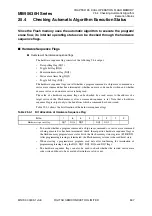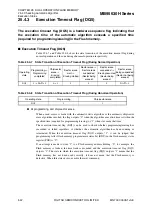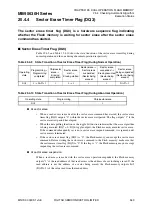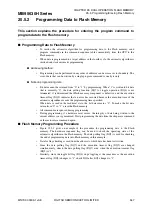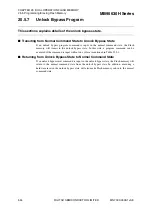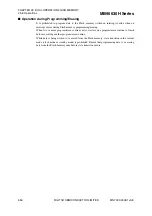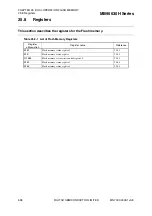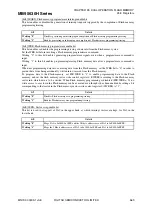
MB95630H Series
550
FUJITSU SEMICONDUCTOR LIMITED
MN702-00009-1v0-E
CHAPTER 25 DUAL OPERATION FLASH MEMORY
25.5 Programming/Erasing Flash Memory
25.5.4
Erasing Specific Data from Flash Memory (Sector
Erase)
This section explains the procedure for entering the sector erase command to
erase a specific sector in the Flash memory. Sector-by-sector erase is enabled
and multiple sectors can also be specified at a time.
■
Erasing Specific Data from Flash Memory (Sector Erase)
To erase data from a specific sector in the Flash memory, send the sector erase command
mentioned in the command sequence table continuously from the CPU to the Flash memory.
●
Specifying a sector
•
The sector erase command is executed in six bus operations. A minimum of 35 µs sector
erase wait time starts as an address in the sector to be erased is specified as the address for
the sixth cycle and the sector erase code (0x30) is written as data.
•
To erase data from multiple sectors, write the erase code (0x30) to an address in sector to
be erased after programming the sector erase code to the address of the first sector to be
erased as explained above.
●
Note on specifying multiple sectors
•
Sector erase starts as a minimum of 35
μ
s sector erase wait time elapses after the last sector
erase code has been written.
•
To erase data from multiple sectors simultaneously, input the addresses of sectors to be
erased and the erase code (in the sixth cycle of the command sequence) within 35 µs. If the
erase code is input after 35 µs elapses, it will not be accepted due to the end of the sector
erase wait time.
•
The sector erase timer flag (DQ3) can be used to check whether it is valid to write sector
erase codes continuously.
•
Specify the address of a sector to be erased as the address at which the sector erase timer
flag (DQ3) is read.
■
Flash Memory Sector Erase Procedure
•
Hardware sequence flags can be used to check the state of the automatic algorithm in the
Flash memory. Figure 25.5-2 gives an example of the Flash memory sector erase
procedure. In this example, the toggle bit flag (DQ6) is used to check the end of sector
erase.
•
The toggle bit flag (DQ6) stops toggling the output at the same time as the execution
timeout flag (DQ5) changes to "1". Check the toggle bit flag (DQ6) even when the
execution timeout flag (DQ5) is "1".
•
Since the data polling flag (DQ7) and the execution timeout flag (DQ5) are changed
simultaneously, check the data polling flag (DQ7).
■
Note on Erasing Data from Sectors
If a hardware reset occurs while data is being erased, the integrity of data in the Flash memory
is not guaranteed. Therefore, run the sector erase procedure again after a hardware reset occurs.


